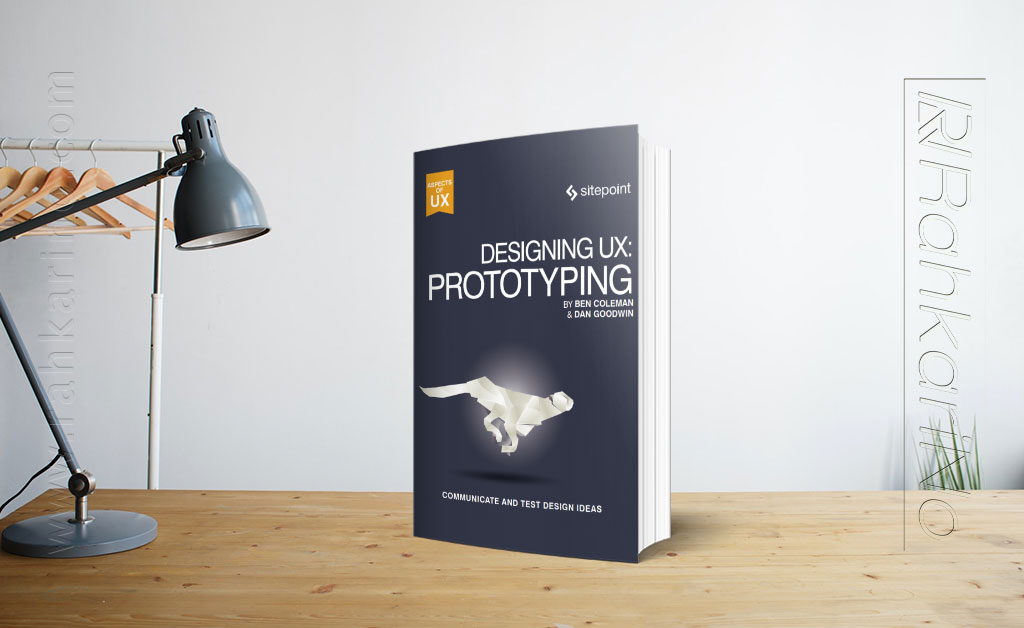
کتابی که مشاهده می کنید از انتشارات SitePoint است که به زبان انگلیسی منتشر شده است.
کتاب الکترونیکی DESIGNING UX PROTOTYPING شامل 214 صفحه است که پس از ثبت نام رایگان، می توانید آن را در دو فرمت PDF و EPUB دانلود نمایید.
سرفصل های کتاب
Foreword……………………………………………………………… xiv
Who Should Read This Book …………………………………………………………… xv
Conventions Used …………………………………………………………………………… xv
Tips, Notes, and Warnings…………………………………………………….. xv
Supplementary Materials………………………………………………………………..xvi
Chapter 1 Defining the Case for Prototyping..1
What is prototyping?…………………………………………………………………………1
Why use prototypes? …………………………………………………………………………3
Testing and Communicating UI Designs………………………………….3
Saving Time and Money ………………………………………………………….3
Bringing Users into the Design Process…………………………………..4
Engaging Stakeholders in a Meaningful Way………………………….7
Designing across Devices and Platforms …………………………………7
Creating and Testing with Real Content and Data………………….9
What can we prototype? …………………………………………………………………11
Information Architecture and Structural Elements……………….11
Layout and Visual Hierarchy ………………………………………………….12
iv Designing UX: PrototypingInteractive Elements………………………………………………………………14
What can’t we do with a prototype? ………………………………………………16
Use Quantitative Research to Make Decisions ………………………16
Testing for Completion/Conversion Funnel Progress……………..16
Testing Accessibility……………………………………………………………….17
Testing the Impact of Visual Design………………………………………17
Being the Sole Source of Documentation……………………………..17
Who are prototypes for?………………………………………………………………….18
Designers……………………………………………………………………………….18
Developers……………………………………………………………………………..19
Project and Account Managers……………………………………………..19
Business Analysts…………………………………………………………………..20
Customer Support Representatives……………………………………….20
Summary………………………………………………………………………………………….20
Chapter 2 The Prototyping Process ……………….22
When to Prototype ………………………………………………………………………….23
You have an Idea …………………………………………………………………..23
Buy-in from Others ……………………………………………………………….23
Information Architecture to Visualize, Present, and Test………24
Table of Contents vA Lengthy User Journey or Several Changes of State over
Time……………………………………………………………………………………….24
A Pool of Available Users……………………………………………………….25
Communicate and Test Designs across Devices……………………..25
Lots of Ideas–or No Ideas–for Solving a Problem………………….26
More Time Spent Communicating than Developing ……………..29
Specific Aspects of a Design Are Performing Poorly ……………..29
Planning…………………………………………………………………………………………..30
What are you aiming to achieve?………………………………………….30
What will you test and demonstrate?……………………………………30
Where will you place the boundaries?…………………………………..31
How will you use your prototype?…………………………………………34
Who will work on your prototype, and how?………………………..35
How much time, budget, and resources do you have? ………….36
What’s the starting point for your prototype?………………………36
Gather Resources …………………………………………………………………………….37
Existing Design Resources……………………………………………………..37
Stationery (for paper prototyping)………………………………………..38
Content………………………………………………………………………………….38
Data……………………………………………………………………………………….39
Get On With It!………………………………………………………………………………..40
vi Designing UX: PrototypingStarting Top-down versus Bottom-up…………………………………..40
Recycling Your Material ………………………………………………………..41
Working Collaboratively ………………………………………………………………….41
Iterate and Demo, Testing Early and Often ……………………………………..42
Summary………………………………………………………………………………………….42
Chapter 3 An Overview of Prototyping Tools
and Techniques …………………………………………………….44
Segmenting and Categorizing Tools and Techniques………………………45
Design Fidelity……………………………………………………………………….45
Tool Complexity and Speed of Use ………………………………………..48
The Aim of Your Prototype ……………………………………………………49
Sorting Tools and Techniques into Our Three Categories………………..49
How the Tools Have Been Grouped …………………………………………………53
Tools that Failed to Make the Cut……………………………………………………53
Summary………………………………………………………………………………………….54
Chapter 4 Paper Prototyping …………………………..56
What is paper prototyping? …………………………………………………………….56
Pros………………………………………………………………………………………..57
Table of Contents viiCons……………………………………………………………………………………….59
Making Paper Prototypes…………………………………………………………………60
What You’ll Need …………………………………………………………………..60
Your Approach……………………………………………………………………….61
Drawing Tips………………………………………………………………………….75
Paper Prototypes from Digital Files……………………………………….77
Collaboration = Team + Client + Users……………………………………………78
Collaborative Creation of Prototypes…………………………………….78
“Responsifying” an Existing Site with Paper Collage……………………….80
Screen Capture………………………………………………………………………81
Printing and Converting to PDF for Large Images…………………81
Slicing and Dicing………………………………………………………………….83
Creating a New Design ………………………………………………………….84
Sketching the Gaps ……………………………………………………………….86
The Finished Article ……………………………………………………………….87
Paper Prototypes in Use…………………………………………………………………..88
Presenting Ideas and Soliciting Feedback ……………………………..89
Testing the Prototypes with Users…………………………………………89
Roles in the Test Session………………………………………………………..90
Anatomy of a Test Session …………………………………………………….91
Digitizing Paper Prototypes …………………………………………………..92
viii Designing UX: PrototypingSummary………………………………………………………………………………………….92
Chapter 5 Creating Clickable Prototypes
from Designs………………………………………………………….93
Marvel ……………………………………………………………………………………………..95
Clickable PDFs………………………………………………………………………………….98
Linking between Pages in a Design Tool………………………………..98
Editing an Existing PDF to Add Hyperlinks ……………………………99
Tools Dedicated to Creating Clickable Prototypes ……………………….. 101
Summary………………………………………………………………………………………..107
Chapter 6 Integrated Tools for Drawing and
Creating Prototypes …………………………………………..108
Common Features in this Category of Prototyping Tools…………….. 109
Drawing and Design Features…………………………………………….. 109
Increased Support for Prototyping Interactivity………………….110
Prototyping Workflow Features…………………………………………..110
Balsamiq ………………………………………………………………………………………..110
OmniGraffle……………………………………………………………………………………116
Axure ……………………………………………………………………………………………. 121
Table of Contents ixKeynote and PowerPoint……………………………………………………………….129
Three Approaches for Using Keynote and PowerPoint for
Prototyping………………………………………………………………………… 131
Sharing Prototypes Created in Keynote and Powerpoint……136
Adobe XD………………………………………………………………………………………139
Summary……………………………………………………………………………………….144
Chapter 7 Building HTML Prototypes ………..146
The Pros of Using HTML ………………………………………………………………..147
Responsive Design ………………………………………………………………147
Flexibility…………………………………………………………………………….147
Complex Interactions………………………………………………………….147
Latest Technology ……………………………………………………………….147
Resources…………………………………………………………………………….147
Source Control for Collaboration………………………………………..148
Source Control for a Historical Record……………………………….148
Various Sources of Content ………………………………………………..148
Accessibility ………………………………………………………………………..148
Speed of Change…………………………………………………………………148
And a Few Cons of HTML………………………………………………………………149
Learning Challenges……………………………………………………………149
x Designing UX: PrototypingExperience Limitations………………………………………………………..149
Planning is a Must………………………………………………………………149
Your HTML Prototype Planning Kit……………………………………………….150
User Research ……………………………………………………………………..150
Content……………………………………………………………………………….150
Structure and Functionality………………………………………………..150
Skills Required ………………………………………………………………………………150
Tools for Rapid Prototyping …………………………………………………………. 151
Preprocessors for Writing CSS……………………………………………. 151
Tools for Interactivity………………………………………………………….153
Making Headway with Frameworks ……………………………………155
Using Content in Prototypes…………………………………………………………160
Using a Content Management System (CMS)……………………………….162
Example CMSs Used for Prototyping ………………………………….163
Creating Accessible Prototypes……………………………………………………..164
Making Prototypes Available Online …………………………………………….165
Sharing Your Prototype Remotely ………………………………………165
Moving Flat File Prototypes Online …………………………………….165
Moving Content-managed Prototypes Online ……………………165
Tools to Automate Deployment ………………………………………….166
Managing Databases…………………………………………………………..166
Table of Contents xiHosting Providers………………………………………………………………..166
Throwaway versus Reusable Code in HTML Prototypes…………………166
HTML Prototyping Case Studies ……………………………………………………167
Dorothy House Hospice Care ………………………………………………168
An Online Store………………………………………………………………….. 170
MacGuffin………………………………………………………………………….. 171
BBC Nature Prototype iPad App………………………………………….173
Summary……………………………………………………………………………………….175
Chapter 8 Using Prototypes in Your Project
Workflow………………………………………………………………176
Exploring and Communicating Design Ideas with the Team ………..177
Engaging with Stakeholders and Project Teams…………………………… 181
Share at the Right Time, and Keep Sharing ………………………..182
Ensure Stakeholders Are Seeing the Latest Version…………….183
Efficiently Use Stakeholders’ Time and Attention ………………183
Keep Promoting the Prototype……………………………………………183
Be Prepared for Stakeholder Feedback……………………………….184
Bringing Users into the Design Process Using Prototypes…………….185
Exploring Motivations and Behaviors in Contextual
Research ……………………………………………………………………………..185
xii Designing UX: PrototypingTesting Your Designs with Users………………………………………….186
Summary……………………………………………………………………………………….189
Appendix A Supplementary Prototyping
Tools Worth Seeking …………………………………………191
Craft by InVision…………………………………………………………………………… 191
Facebook Origami Studio ……………………………………………………………..192
Framer…………………………………………………………………………………………..193
Principle………………………………………………………………………………………..195
Xcode…………………………………………………………………………………………….196
درخواست مشاوره
برای کسب اطلاعات بیشتر درباره این دوره درخواست مشاوره خود را ارسال کنید و یا با ما در تماس باشید.
درخواست مشاورهدوره های مرتبط
کتاب الکترونیکی PROJECT MANAGEMENT
PROJECT-MANAGEMENT
کتاب الکترونیکی PHP-MYSQL NOVICE TO NINJA
PHP-MYSQL NOVICE TO NINJA
کتاب الکترونیکی JAVASCRIPT NOVICE TO NINJA
JAVASCRIPT NOVICE TO NINJA
نظرات
رایگان!




قوانین ثبت دیدگاه